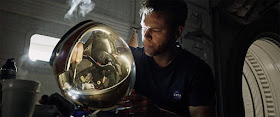I'm going to have to science the shit out of this.
Until I saw the trailer for The Martian, I was completely unaware of the best-selling self-published 2011 novel by Andy Weir that provided the original story for the movie. Intrigued by the concept, I took the book with me as vacation reading on a long weekend getaway, and found myself completely caught up in the trials and tribulations of American astronaut Mark Watney, left for dead on Mars after a piece of debris knocks him out and disables his suit telemetry during the evacuation of his mission team due to a dangerous dust storm.Mark Watney, The Martian
When Watney regains consciousness, he finds himself alone and stranded, faced with the very basic challenge of staying alive, followed by the longer term project of contacting Earth in hopes of being rescued before he runs out of food. Watney's first person mission logs detail his ingenious solutions to the obstacles that he needs to overcome in order to successfully meet these two challenges.
Weir stacks the deck in Watney's favour in a couple of ways.* First, the marooned astronaut is an engineer/botanist, the perfect combination for the situation – there might well have been a completely different outcome if the stranded crew member had been a psychiatrist/pilot. Second, NASA has conveniently provided a few raw potatoes for the crew’s Thanksgiving dinner, which gives Watney immediate access to something that he can cultivate in the mission's habitat in order to extend his food supplies.
I found it to be a fun, entertaining read, although not terribly deep (any book which relies heavily on jokes about 70s television shows is not going to challenge Crime and Punishment in terms of psychological depth) and completely enjoyed it. Oddly enough, I'm not sure I’d recommend the book to everyone, although I suspect it’s going to work very well as a movie, especially with Matt Damon providing the voice - and face - for Watney's narrative.
Why wouldn’t I recommend the book to all and sundry? The plot of The Martian is made up of an extended series of scientific solutions to the problems of survival, solutions that are heavily based in math, chemistry and physics.** Weir does an excellent job of making the science comprehensible, but even so, there's an awful lot of discussion of caloric units, wattage, surface areas, molecular composition and so on.
I've always been more interested in the more scientific side of science fiction, and as such I found Watney's solutions to be ingenious and interesting, but I know a few people who would blink a few times and then abandon the book in favour of less technical narrative.
However, the real question that The Martian raises is one that we have yet to face in our limited exploration of space: how far would we go to rescue an astronaut marooned in space? Space travel relies on a limited supply of resources and hardware which are incredibly expensive and time-consuming to assemble and construct. Would we spend millions of dollars and jeopardize other missions in order to stage a rescue effort which might not even succeed?
Regardless of the manner in which that question is answered in The Martian***, I'd like to think that we would. In my mind, there's an unspoken covenant between humanity and the people that have chosen to be our pathfinders into the universe, a covenant that says that if they find themselves in peril, we will do everything in our power to rescue them - it would be a betrayal of their dedication and courage to do anything less.
- Sid
* This is surprisingly common in castaway stories. The original Robinson
Crusoe has an entire sailing ship full of supplies to draw upon: guns,
gunpowder, tools, wood, clothing, canvas, and so on. The astronaut in the 1964 movie Robinson Crusoe on Mars miraculously (and improbably)
discovers open water, edible aquatic plants, rocks that release oxygen when
heated, and an alien man Friday. Tom Hanks gets the contents of random
FedEx™ packages – including a volleyball.
** I spent about thirty minutes looking for an official name for the physics trick
involving lateral pressure on a taut cable that Watney uses to get a flipped Mars rover upright again, without ever finding the right search terms to get the results I wanted. If anyone finds out what it's called, please leave a comment!
*** No spoilers here, Dorothy.






